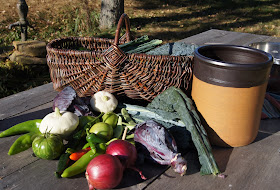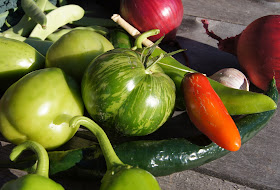At around 6:00 last night, as the sun was slipping down
behind the big cottonwoods, the temperature here at the farm had dropped to the
upper 40s. The sky was clear and the
winds were calm. I looked out at the
gardens, and I thought, Ruh-roh. I’d
seen a forecasted low of 38, and down here in the valley you can usually
subtract a few degrees from that.
Indeed, such are the microclimates in our hilly section of Dunn County , Wisconsin
I briefly considered a hurried harvest. Then I said, Aw, skip it. If it’s gonna freeze on September 13, it’s
gonna freeze. We’ve had frost at
Bide-A-Wee as early as August 25, so it wasn’t out of the question by any means. But as I made some dinner preparations and
the sky grew darker, the thermometer’s needle stayed put. Maybe it was stuck. I gave it the benefit of the doubt, and
decided that we would prob ably be
all right. I put on some wool socks,
poured myself a drink, and went out to sit by the fire and listen for the
barred owls and coyotes.
6:30 this morning I got up and peeked out at the basil in a
planter on the deck. It was green and perky. Basil, cucumbers, and green beans are the
tenderest of crops, in my experience, indicator species in that regard, if you
will. If the basil was okay, the rest
would be fine. There wasn’t even frost
on the car tops, just a heavy dew. Now
the next few days look clear of frost danger, but it is the middle of September,
and the end is near. So as the sun
warmed the yard on this splendid early fall morning, I made a tour of the gardens,
picked a basketful of prime produce, and set about filling my crock. A ferment like this is always a bit of an
experiment: I have never fermented summer squash or green tomatoes, for
instance, though Sandor Katz says they work well in a mixed crock. Chiles
Rinse everything well, especially the kale: all those attractive crenellations are
custom-made for catching dust, and that stuff has been standing out there near
the crossroads for months.
I stripped the kale from the stems, chopped it roughly, and
massaged it with salt, mainly to get the volume down and make more room in the
crock.
These little red cabbages were ones I thinned from my
over-planted cabbage patch. These too
required careful cleaning, as it turns out some slugs were still in residence
there. Hate slugs, absolutely hate ‘em. I cut these into quarters or sixths. I’m not sure why the variation; just a whim.
Four kinds of chiles went in: Anaheim
For flavor I added a red onion and a few cloves of garlic—I’ll
prob ably tuck in a few more cloves
of garlic in a few days, but our kitchen supply was running low.
Working out in the yard on this absolutely splendid morning was pleasant duty, indeed. The colors and textures of the vegetables in that clear northern light made a visual feast that has me anticipating the culinary feasts ahead even more.
When the crock was well packed I took it inside and added brine consisting of 6 tablespoons (3/8 cup or about 90 grams) of sea salt dissolved in a half gallon of warm water. I have a little plate that fits exactly inside the mouth of my crock, water-filled measuring cup atop that to weight it down. In the next couple of days the contents should compact significantly, and then I can add a few more vegetables if I want to.
Fermented vegetables are delightful chopped as hot dog or sandwich garnish, for sure, but at our house their main role is as soup base. The tangy, crunchy vegetables take up so much flavor in the process of fermentation, they add a remarkable freshness to our winter soups. I think of these as borscht variations, though they may not contain beets. And that reminds me that there are still plenty of beets out in the garden, and I should check on how my late planting of golden beets is coming along.
It is a bounteous time, to be sure, and while the end is
near for the cold-sensitive crops, it’s only after a couple of good frosts that
the hardier vegetables like kale, cabbage, Brussels sprouts, and turnips really
come into their prime. Carrots are sweeter
after a frost. Lettuce can take a good
bit of chill, too. There is plenty of
good eating ahead.
And now I'm curious to know, as I'm certain many of you reading this are avid fermenters: What's in your crock? What sorts of things have you had success fermenting, and which ones haven't work out as well? Please do tell. And happy fermenting to all.
Text and photos copyright 2012 by Brett Laidlaw
And now I'm curious to know, as I'm certain many of you reading this are avid fermenters: What's in your crock? What sorts of things have you had success fermenting, and which ones haven't work out as well? Please do tell. And happy fermenting to all.
Text and photos copyright 2012 by Brett Laidlaw










I just made a large batch of kimchee with two beautiful napa cabbages from the farmers market. The smell was so intense while it was fermenting that we all had strange dreams.
ReplyDeleteAlso recently fermented: a whole quart of jalapenos, just straight up in saltwater brine, and bread and butter pickles in an apple cider vinegar brine.
I'm curious to hear how the kale turns out. I have a ton of it, but I've never fermented it before.
Just a note to add (besides cool post) that I am the polar opposite of volu-man! I'm totally the person who makes extra dishes due to vast over and under-estimates of how much will fit!
ReplyDeleteStill feeling newbie-ish about fermenting but we did make some awesome full sours this year. Oh and beer, so that counts for something, right?
Jennifer, I saw your tweet about the kimchee nightmares! Hope you weren't fermenting it in the bedroom. How did your jalapenos turn out? I've done red kale the same way I do 'kraut in jars, just the shredded veg and salt, no added water. That was really interesting--it had a kimchee, sea-weedy quality even though it was just kale and salt.
ReplyDeleteSara, you can be my sidekick, Poor Volume Perception Girl. Together we will have negligible impact on anything.
Sour dills and 'kraut are my must-do ferments. I've got a couple gallons of the dills going, but I wait for post-frost cabbages to make my 'kraut, generally.
Beer counts for a lot. A really lot.
Cheers~ Brett
g Just a little "off topic"...but I am just as interested in your beautiful red osier basket as I am in the fermented vegetables. Does it have a story?
ReplyDeleteHi Joyce: The basket, yes: I'm glad you noticed its not-so-inconspicuous placement in the photos! We got that in Brittany a few years ago. We were staying at a gite, general area of Rennes, and driving around the countryside one afternoon we saw a sign for a "vannerie", and followed it to the home and workshop of a woman who made beautiful baskets of all shapes and sizes. We bought a couple and the one pictured became our picnic basket on the trip, market/garden basket here at home. It's a shape traditionally used for gathering oysters in Brittany.
ReplyDeleteSalut~ Brett